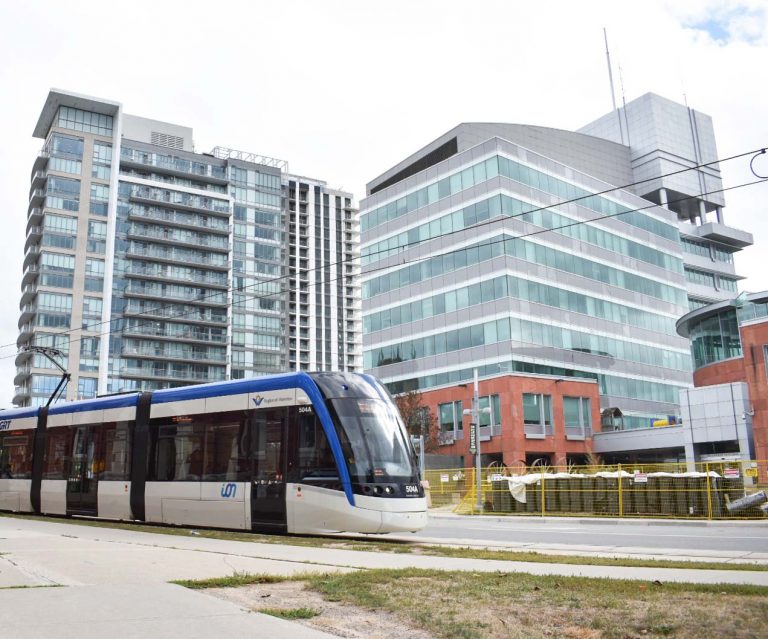This summer marked the third anniversary of the ION Light Rail Train (LRT) in K-W.
The Grand River Transit staff provide an invaluable service to the city and have always carried themselves in a helpful and professional manner. The problem lies within the decisions made by the Waterloo Regional Council, who made launching the LRT a lengthy and expensive mess paid for by taxpayers. Not only was the slow development of the LRT a bumpy ride, but the council’s lack of awareness of socioeconomic inequalities in the region also gave rise to transit-induced gentrification along the LRT corridor.
This centralized transit corridor places the LRT in high retail traffic areas but undermines access to low to middle income neighbourhoods for families and marginalized groups. The LRT primarily benefits those who already live in close proximity to high retail traffic areas. This does not make the LRT more accessible or easier for people who are reliant on public transportation.
The intersection of King St and Victoria St was once home to many of locally owned businesses but is now the heart of the tech industry in KW. It is now also home to numerous luxury-condo developments that are geared towards those who can afford an average of over $1700 per month for a one bedroom condo.
Then, just up the road on King St. W., surrounding one of the busiest hospitals in the tri-cities, is another collection of luxury- condominiums. Near city hall, large luxury condos on Charles St., Duke St., Young St. and so on cast a bleak shadow of unaffordability over the core of the city.
This is the same story on King St. E., which had bravely fought off the gentrification that was occurring in the downtown core for years. King St. E. is home to the bustling Kitchener Market, iconic Asian grocers and other quintessential local businesses that have defined Kitchener’s culture for decades are now overshadowed by a set of unaffordable luxury developments as well.
Unsurprisingly, all of these places are being built within walking distance of LRT stops. Thus, it is clear to see that transit-induced gentrification is in full effect along the central transit corridor.
In 2019, Dave Jaworsky, mayor of Waterloo, spoke to the CBC about the LRT and growing tech sector in the region.
“[…]both downtown Kitchener and uptown Waterloo, for example, have changed for the better,” Jaworsky said.
This is a dangerously uninformed stance by Jaworsky. Both violent crimes and property crimes have increased year over year since 2014, and the inept Waterloo Regional Police Service has failed the residents of the region by not solving more than half of the crimes committed in the region.
Berry Vrbanovic, mayor of Kitchener, is also guilty of this ignorance as he boasted about the growth of luxury condos coinciding with the LRT development.
“We’re already seeing the significant benefits in terms of what it’s doing to real estate in the area and the new investments in terms of buildings going up instead of out into suburbia.” Vrbanvic told the Record in 2016.
What did Jaworsky and Vrbanovic mean? Who has experienced a “better” Kitchener or a “better” Waterloo? Are Jaworsky and Vrbanovic really talking about the same K-W that we are living in? Maybe they are speaking for those who have been privileged enough to live along the LRT corridor in the downtown and uptown core, but not taking into account those who have been affected by the gentrification and displacement that followed the development of the LRT.
Transit-induced gentrification in K-W means there won’t be low to medium income families, seniors and disabled people living near the central transit corridor, nor will family businesses prosper from the gentrification. Entrances near the LRT are simply unaffordable, and the smaller sized units discourage families from residing in these condos.
The side effects of LRT were both a population boom and a real estate surge in the tri-cities, but it did not improve the lives of riders who are reliant on public transportation, nor did it support the possibility for families to live in Downtown or Uptown.
The LRT was developed to encourage the Waterloo Region to reach a growth target of 742,000 by 2031, and promote real estate and business growth to maintain a low unemployment rate in the region. Unfortunately, the reality is grim;, small businesses are being priced out by relentless landlords, longtime residents of KW are struggling amid the unaffordable housing climate, crime rates are higher than ever, encampments are becoming more prevalent and the unemployment rate is also rising.
Cambridge will inevitability be hit with the hard wave of gentrification along their side of the tracks once development of the LRT extension takes place.
This isn’t a new phenomenon; neighbourhoods in North York felt the pressures of gentrification when Toronto’s LRT system extended into Flemingdon Park and Eglinton West.
Waterloo Region Council has to make a decision on whether they want the $800+ million dollar LRT creation to be an exemplary form of transit-induced gentrification and a leading force of displacement, or to understand the holistic needs of marginalized populations and communities.
Simply ignoring the elephant in the room will continue the trends of housing instability, encampments, and more crime.
For now, we can only hope that affordable housing and equitable city planning remains at the forefront when the mayoral and council elections take place.
The Elephant is a column about a major underlying issue in the region, the metaphorical elephant in the room: gentrification. Saajan Kar is a lifelong Kitchener resident and a student at the University of Waterloo Faculty of Arts. He is interested in social justice issues, local politics and issues impacting marginalized communities.

